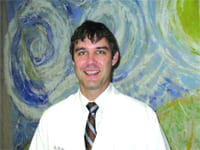I Can See Clearly Now No Stitches, No Glasses: the Evolution of Cataract Surgery
Of all the things Dr. Andrew Jusko does as an ophthalmologist, he says he’s most gratified by cataract surgery.
“This is the most satisfying because of how happy you can make somebody, and how quickly,” said Jusko, a partner with Eyesight & Surgery Associates in Springfield. “In this practice, I see many patients with very advanced cataracts. For a variety of reasons, they let their cataracts get very dense before seeking help. In this situation, the effects are even more dramatic.”
The results he speaks of are an improvement in vision that often surprises the patient, who is often able to see not only clearly, but without the need for glasses or contact lenses, even if they wore them before developing cataracts.
Other eye doctors report similar results.
“Some patients are seeing 20/20 the first day they come back,” said Dr. John Warren, who co-owns Eye & Lasik Center in Greenfield. “It’s a much quicker procedure, much safer, with a lower complication rate and more predictable results, and that’s due almost entirely to technological advances.”
As part of this month’s focus on eye care, The Healthcare News takes a closer look at what those advances are, and why they have patients seeing the light — and much more.
Obstructed View
A cataract is a clouding that develops in the crystalline lens of the eye or in its envelope. It can vary from slight to complete opacity, and generally obstructs the passage of light. Cataracts can eventually cause vision loss and are potentially blinding if left untreated. The condition usually affects both the eyes, although one eye is usually affected earlier than the other.
“Cataracts are basically opacities that develop in the lens,” Jusko explained. “Certain things like ultraviolet light and oxidation damage from aging will cause cataracts to develop, and when it becomes difficult enough to see and people are starting to have problems with glare haloes, trouble seeing the small print when reading, or not seeing the bottom of the television screen, that’s when they start to have problems.
“They occur mainly in older people,” he added, “but if you live long enough, you will develop cataracts.”
Before he recent breakthroughs in lens-implant technology, which allows patients to see much more clearly after surgery, other advances had begun to make cataract removal a safer, less-traumatic experience.
“Probably the most important thing that has happened with cataract surgery in the past 20 years is that implants are now made out of a material that can be folded and slid through a small incision,” Jusko said, as opposed to making the incision the size of the lens itself.
“Now you can fold them and put them in through small incisions, so if you make the incision small enough, you can also bevel it in a way that allows it to seal without sutures,” he added, noting that the technique has become industry standard. “People have been doing no-suture surgery for some time.”
Before that, Warren said, cataract-surgery patients used to be hospitalized upwards of a week with sandbags placed to immobilize the head. “But with the last few decades of advancing technology, now it’s a 10-minute outpatient procedure,” he explained.
Another important advance has been the use of topical anesthesia.
“In the past, everyone would get a shot into the eye socket to numb it up completely, but there’s some risk in giving this sort of anesthesia, such as bleeding, particularly in people who need to be anticoagulated,” Jusko explained. “So topical anesthesia, which is usually a viscous lidocaine solution, to numb the surface, is really sufficient for adequate anesthesia.
“So, those are the biggest advances of, say, the last 10 to 15 years. But now, we’re getting good at the accuracy of the implant.”
The new, advanced lens implants, quite simply, perform the same function as glasses.
“We’ve seen some exciting changes with lens-implant technology,” Warren said. “Previously, after we did a cataract procedure, the patient would require an update in their glasses, typically bifocals. Now, we can match each lens implant to what the individual needs, and following the procedure, the lens implant is doing the work, and they no longer need glasses.”
In other words, Jusko said, while the advances in no-stitch surgery and local anesthetics made cataract treatment safer, they didn’t necessarily improve patient outcome. “But this refractive component is such that we can often reduce or eliminate the need for glasses after surgery.”
Cost and Effect
Jusko said many people still aren’t aware of the high-tech options for cataract surgery, and live with the condition for far too long. But cost is a factor for many people, as insurance typically doesn’t cover the full price of premium lens implants.
“This technology is a few generations from its birth, so it’s getting much better, but the downside to these premium lenses is that there’s an out-of-pocket cost that can be fairly expensive,” he said. But for those who can afford it, it’s often an easy choice.
“I guess the key is, once a surgeon feels comfortable with their ability to get somebody’s vision right on target, then it’s better to use the premium lenses and achieve excellent results quicker and with lower risk.
“The results speak for themselves,” he added. “Patients are very happy.”


Comments are closed.